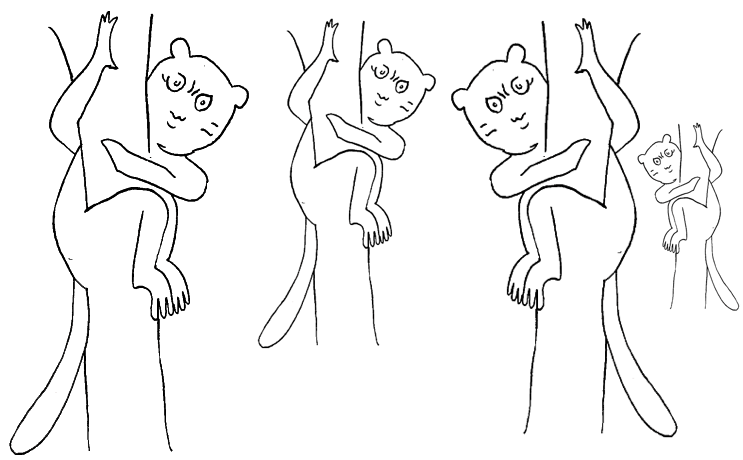
レヴィンティン効果
Levitin effect

☆ レヴィティン効果とは、音楽教育を受けていない人でも、曲を正しい調で覚えている傾向がある現象のことである。この発見は、知覚体験の詳細は記憶のエン コードの過程で失われるため、人は絶対音感ではなく相対音感でメロディーを覚えているという、多くの実験室での研究結果とは対照的である。 この効果は1994年にダニエル・J・レヴィティンによって初めて報告され、認知心理学における重要な結果として評価された。[1][2][3][4] 2012年に、この効果は初めて再現された。[5] この効果の発生の可能性に関する理論や、相対音高と絶対音高を区別する能力の個人差に関する理論がある。[要出典] 認知障害は、レヴィティン効果を体験する能力に影響を与える可能性がある。[要出典]
| The Levitin effect
is a phenomenon whereby people, even those without musical training,
tend to remember songs in the correct key. The finding stands in
contrast to the large body of laboratory literature suggesting that
such details of perceptual experience are lost during the process of
memory encoding, so that people would remember melodies with relative
pitch, rather than absolute pitch. The effect was first documented by Daniel J. Levitin in 1994 and was regarded as a significant result in cognitive psychology.[1][2][3][4] In 2012, the effect was replicated for the first time.[5] There are theories as to the possible development of this effect and a strong differentiation between a person's ability to distinguish relative pitch versus absolute pitch.[citation needed] Cognitive disorders can affect a person's ability to experience the Levitin effect. [citation needed] |
レヴィティン効果とは、音楽教育を受けていない人でも、曲を正しい調で
覚えている傾向がある現象のことである。この発見は、知覚体験の詳細は記憶のエンコードの過程で失われるため、人は絶対音感ではなく相対音感でメロディー
を覚えているという、多くの実験室での研究結果とは対照的である。 この効果は1994年にダニエル・J・レヴィティンによって初めて報告され、認知心理学における重要な結果として評価された。[1][2][3][4] 2012年に、この効果は初めて再現された。[5] この効果の発生の可能性に関する理論や、相対音高と絶対音高を区別する能力の個人差に関する理論がある。[要出典] 認知障害は、レヴィティン効果を体験する能力に影響を与える可能性がある。[要出典] |
| Levitin effect studies Levitin's original study consisted of 46 volunteer students from Stanford University asked to participate in the study. Upon arrival, the students filled out a background questionnaire and selected two songs from 56 previously chosen CDs. Volunteers then attempted to sing a part of their songs. The study's results showed that 40% of the participants could sing a correct pitch in at least one of their songs. 12% hit the right pitch on both trials, and 44% hit the pitch within two semitones.[1] The second study was conducted in 2012 and completed in six European Labs. This study was a competitive replication of Levitin's original study. This showed that 25% of participants could sing the correct pitch in at least one of their songs; 4% sang the correct pitches in both songs.[6] These studies demonstrate that people can typically remember songs in a way that is similar to how they heard them, even without a reference to the music. When compared to Levitin's original study, the replication showed a lower trend in the data, indicating that a smaller percentage of the population was able to recall the relative pitch. More data is needed to understand how much of the population can accurately recall the relative pitch of a selected song. |
レヴィティン効果の研究 レヴィティンの最初の研究は、スタンフォード大学の学生46人を対象に行われた。学生たちは、到着後、背景に関する質問票に回答し、事前に選ばれた56枚 のCDから2曲を選んだ。その後、ボランティアは選んだ曲の一部を歌おうと試みた。研究の結果、参加者の40%が少なくとも1曲で正しい音程で歌えたこと が判明した。12%は両方の試行で正しい音程を捉え、44%は2半音以内の音程で歌えた。[1] 2 回目の研究は 2012 年に実施され、ヨーロッパの 6 つの研究所で完了した。この研究は、レヴィティンの最初の研究を再現した競争的な研究だった。その結果、参加者の 25% が少なくとも 1 曲は正しい音程で歌うことができ、4% は 2 曲とも正しい音程で歌った。[6]これらの研究は、人々は通常、音楽を参照しなくても、聞いたとおりに曲を覚えていることを示している。レヴィティンの元 の研究と比較すると、再現研究ではデータに低い傾向が見られ、相対的な音高を思い出せる人口の割合が低いことを示している。 選択した曲の相対的な音高を正確に思い出せる人口の割合を把握するには、さらに多くのデータが必要である。 |
| Possible developments Levitin offers possible explanations for this phenomenon, by describing how even young children have this ability to a certain degree, so this ability to recognize musical patterns could be located in the cerebellum of the brain.[7] The cerebellum helps to control balance and coordination, but when listening to music, the cerebellum helps the body interpret rhythm. Researchers at Lawrence Parsons and Peter Fox of University of Texas Health Science Center ran brain scans on conductors and saw an increase of blood flow to the cerebellum when they were following along to sheet music and listening to it at the same time. The scans showed that as the rhythm changed, the amount of blood flow in the cerebellum changed as well.[8] There are a few theories that try and explain this occurrence. One theory states our ancestors needed to synchronize their steps in nature to avoid making more noise than necessary while hunting. Another theory suggests that those early humans who were able to distinguish rudimentary rhythms may have been able to hear and interpret different footsteps making them more attuned to the environment around them and have better survival instincts.[9] Those who distinguish different sounds in the environment were more likely to survive and pass along their genetics. These are just possible theories as to how humans have developed pitch and rhythmic interpretation. There is no distinct evidence proving or disproving these theories. |
考えられる展開 レヴィティンは、この現象について、幼い子供でもこの能力がある程度備わっていることを説明し、音楽パターンを認識する能力は脳の小脳にある可能性がある と指摘している[7]。小脳はバランスや協調を制御しているが、音楽を聴く際には、リズムを解釈する役割も果たしている。テキサス大学健康科学センターの ローレンス・パーソンズとピーター・フォックスは、指揮者を対象に脳スキャンを行ったところ、楽譜を見ながら音楽を聴いていると、小脳への血流が増加する ことがわかった。スキャン結果では、リズムが変わると小脳への血流量も変化することがわかった。[8] この現象を説明する理論はいくつかある。一つの理論は、私たちの祖先が狩りの際に必要以上に音を立てないように、自然の中で歩調を合わせる必要があったた めだとする。別の説では、原始的なリズムを区別できた初期の人類は、異なる足音を聞き分け、周囲の状況により敏感に反応し、生存本能が発達していたのでは ないかと考えられている[9]。環境中の異なる音を区別できる者は、生き残り、その遺伝子を後世に残す可能性が高かった。これらは、人間が音の高さやリズ ムの解釈能力を発達させた理由について考えられる説にすぎない。これらの説を証明または反証する明確な証拠はない。 |
| Absolute vs. relative pitch Absolute pitch, also referred to as perfect pitch, is the ability to correctly identify or recreate a sound or pitch without needing a reference. This ability is rare among humans, but there has been shown to be a correlation between those who were exposed to music while they were babies and those who possess this ability. There is also evidence that this can be genetic, meaning that those who have a family member with absolute pitch are more likely to have it as well.[10] Musicians generally consider perfect pitch helpful, but many successful musicians possess only relative pitch, which is the ability to identify changes in pitch and timbre in music.[11] Relative pitch is far more common in the population, and unlike perfect pitch, it is not believed to be based on any musical training or exposure.[citation needed] In fact, this was what Levitin was attempting to show in his experiments. While most humans have an innate ability to distinguish musical intervals, musicians of many backgrounds find extensive ear training, to formalize their understanding, essential. While most of the human population has some general understanding of pitch, there exist people who are truly "tone-deaf." This inability to process and understand changes in pitch, known as amusia, can be congenital or acquired. |
絶対音感と相対音感 絶対音感(絶対音感、絶対音感)とは、参照音なしで音や音高を正確に識別したり再現したりする能力のことです。この能力は人間には稀ですが、乳児期に音楽 にさらされた人とこの能力を持つ人との間に関連性が示されています。また、この能力は遺伝的である可能性もあり、絶対音感を持つ家族がいる人は、その能力 を持つ可能性が高いことが示されています。[10] ミュージシャンは一般的に絶対音感を役立つ能力と考えるが、多くの成功したミュージシャンは相対音感のみを保有している。相対音感とは、音楽における音の 高さや音色の変化を識別する能力だ。[11] 相対音感は人口の大多数に広く見られ、絶対音感とは異なり、音楽訓練や音楽への曝露に依存しないと考えられている。[出典が必要] 実際、これはレヴィティンが実験で証明しようとしたことだった。ほとんどの人は、音程を区別する生来の能力を持っているが、さまざまなバックグラウンドを 持つ音楽家は、その理解を正式なものにするために、広範な耳のトレーニングが不可欠だと考えている。ほとんどの人は音程について一般的な理解を持っている が、真に「音痴」な人々も存在する。音程の変化を処理・理解できないこの能力は、音痴症として知られており、先天的なものもあれば後天的なものもある。 |
| Cognitive disorders There are certain disorders in the brain that can prevent someone from having the ability to perceive relative pitch. These disorders can be congenital or developed. Amusia is a term used to describe someone who has difficulty differentiating pitch or identifying music. Congenital amusia is often referred to as being tone-deaf. Those with congenital amusia can process speech, differences in people's voices and hear environmental sounds, but most cannot identify patterns in music.[12] They describe it as not being able to "hear" music, which sounds like somebody banging different pots and pans, rather than a rhythmic melody. The level of amusia can differ too. Some people can distinguish different songs and "hear" the music, while others have absolutely no understanding of music. Amusia can also be developed through traumatic brain injuries or lesions and tumours on the brain. Those who once could perceive relative pitch can lose this ability through an event like a head injury in a car crash. Sometimes this condition is reversible, but there is not a way to know if the person will be able to distinguish pitches again.[13] This reason for this condition is not exactly known, but research and brain scans indicate that part of the cause may be located in the frontal cortex of the brain.[14] |
認知障害 相対音感を認識する能力を妨げる、脳のある障害がある。この障害は先天性または後天性である。失調症とは、音の高さを区別したり、音楽を識別したりするこ とが困難な人を指す用語だ。先天性失調症は、しばしば音痴と呼ばれる。先天性失調症の人は、会話や人々の声の違いを認識し、周囲の音を聞くことはできる が、音楽のパターンを識別することはほとんどできない。[12] 彼らは、音楽を「聞く」ことができないと表現し、それはリズミカルなメロディーではなく、誰かが異なる鍋やフライパンを叩いているような音に聞こえると言 う。失聴覚の程度も様々だ。異なる曲を区別し、音楽を「聞く」ことができる人もいれば、音楽をまったく理解できない人もいる。失聴覚は、外傷による脳損傷 や、脳の病変や腫瘍によって発症することもある。かつては相対音感があった人も、自動車事故による頭部外傷などの出来事によってこの能力を失うことがあ る。この状態は回復する場合もあるが、その人が再び音の高さを区別できるようになるかどうかはわからない。[13] この症状の原因は正確にはわかっていないが、研究や脳スキャンによると、その原因の一部は脳の前頭葉にある可能性がある。[14] |
| 1.
D. J. Levitin (1994). "Absolute memory for musical pitch: Evidence from
the production of learned melodies". Perception & Psychophysics. 56
(4): 414–423. doi:10.3758/bf03206733. PMID 7984397. 2. D. Huron (2006). "Exploring How Music Works Its Wonders". Cerebrum.[page needed] 3. "Common expressions: Levitin". Webster's Online Dictionary. Webster's. 2011-02-18. Archived from the original on 2011-07-24. Retrieved 2011-02-18. 4. James Martin (Summer 2004). "A Mind For Music". McGill News. pp. 1–2. 5. "Comparative replication studies of the "Levitin Effect" in five laboratories", KU.edoc. 6. Frieler, Klaus; Fischinger, Timo; Schlemmer, Kathrin; Lothwesen, Kai; Jakubowski, Kelly; Müllensiefen, Daniel (2013-09-04). "Absolute memory for pitch: A comparative replication of Levitin's 1994 study in six European labs". Musicae Scientiae. 17 (3): 334–349. doi:10.1177/1029864913493802. S2CID 8220702. 7. Thompson, Clive (2006-12-31). "Music of the Hemispheres (Published 2006)". The New York Times. ISSN 0362-4331. Retrieved 2020-11-11. 8. Ferber, Dan (1998-11-09). "Sounds of Music in the Cerebellum". Science | AAAS. Retrieved 2020-11-11. 9. Larsson, Matz (2014-01-01). "Self-generated sounds of locomotion and ventilation and the evolution of human rhythmic abilities". Animal Cognition. 17 (1): 1–14. doi:10.1007/s10071-013-0678-z. ISSN 1435-9456. PMC 3889703. PMID 23990063. 10. Moulton, Calum (2014-10-01). "Perfect pitch reconsidered". Clinical Medicine. 14 (5): 517–519. doi:10.7861/clinmedicine.14-5-517. ISSN 1470-2118. PMC 4951961. PMID 25301913. 11. McDermott, Josh H.; Lehr, Andriana J.; Oxenham, Andrew J. (December 2008). "Is Relative Pitch Specific to Pitch?". Psychological Science. 19 (12): 1263–1271. doi:10.1111/j.1467-9280.2008.02235.x. ISSN 0956-7976. PMC 2841133. PMID 19121136. 12. Ayotte, Julie; Peretz, Isabelle; Hyde, Krista (2002-02-01). "Congenital amusiaA group study of adults afflicted with a music-specific disorder". Brain. 125 (2): 238–251. doi:10.1093/brain/awf028. ISSN 0006-8950. PMID 11844725. 13. Stewart, Lauren; von Kriegstein, Katharina; Warren, Jason D.; Griffiths, Timothy D. (2006-10-01). "Music and the brain: disorders of musical listening". Brain. 129 (10): 2533–2553. doi:10.1093/brain/awl171. ISSN 0006-8950. PMID 16845129. 14. Chen, Jian; Yuan, Jie (2016-07-27). "The Neural Causes of Congenital Amusia". Journal of Neuroscience. 36 (30): 7803–7804. doi:10.1523/JNEUROSCI.1500-16.2016. ISSN 0270-6474. PMC 6601881. PMID 27466325. |
1. D.
J. Levitin (1994). 「音楽の音高の絶対記憶:学習したメロディーの再生からの証拠」. Perception &
Psychophysics. 56 (4): 414–423. doi:10.3758/bf03206733. PMID 7984397. 2. D. Huron (2006). 「音楽が奇跡を起こす仕組みを探る」. Cerebrum.[ページ番号不明] 3. 「一般的な表現:Levitin」. ウェブスターオンライン辞書. ウェブスター. 2011-02-18. 2011-07-24 のオリジナルからアーカイブ。2011-02-18 取得。 4. ジェームズ・マーティン (2004年夏)。「A Mind For Music」 McGill News. pp. 1–2. 5. 「5つの研究所における「レヴィティン効果」の比較再現研究」 KU.edoc. 6. Frieler, Klaus; Fischinger, Timo; Schlemmer, Kathrin; Lothwesen, Kai; Jakubowski, Kelly; Müllensiefen, Daniel (2013-09-04). 「音程に関する絶対記憶:ヨーロッパの 6 つの研究所における Levitin の 1994 年の研究の比較再現」。Musicae Scientiae. 17 (3): 334–349. doi:10.1177/1029864913493802. S2CID 8220702. 7. トンプソン、クライブ (2006-12-31). 「半球の音楽 (2006年発行)」。ニューヨーク・タイムズ。ISSN 0362-4331. 2020年11月11日取得。 8. Ferber, Dan (1998-11-09). 「小脳における音楽の音」. Science | AAAS. 2020年11月11日取得。 9. Larsson, Matz (2014-01-01). 「自己生成された運動と換気の音と人間のリズム能力の進化」。Animal Cognition. 17 (1): 1–14. doi:10.1007/s10071-013-0678-z. ISSN 1435-9456. PMC 3889703. PMID 23990063. 10. Moulton, Calum (2014-10-01). 「絶対音感の再考」. Clinical Medicine. 14 (5): 517–519. doi:10.7861/clinmedicine.14-5-517. ISSN 1470-2118. PMC 4951961. PMID 25301913。 11. マクダーモット、ジョシュ H.、レール、アンドリアナ J.、オクセンハム、アンドルー J. (2008年12月)。「相対音感は音高に固有のものか?」。Psychological Science. 19 (12): 1263–1271. doi:10.1111/j.1467-9280.2008.02235.x. ISSN 0956-7976. PMC 2841133. PMID 19121136. 12. エイオット、ジュリー、ペレツ、イザベル、ハイド、クリスタ (2002-02-01)。「先天性音楽障害 音楽特異的障害に苦しむ成人を対象としたグループ研究」。脳。125 (2): 238–251. doi:10.1093/brain/awf028. ISSN 0006-8950。PMID 11844725。 13. Stewart, Lauren; von Kriegstein, Katharina; Warren, Jason D.; Griffiths, Timothy D. (2006-10-01). 「音楽と脳:音楽聴覚障害」. Brain. 129 (10): 2533–2553. doi:10.1093/brain/awl171。ISSN 0006-8950。PMID 16845129。 14. Chen, Jian; Yuan, Jie (2016-07-27). 「先天性音楽障害の神経的原因」。Journal of Neuroscience. 36 (30): 7803–7804. doi:10.1523/JNEUROSCI.1500-16.2016. ISSN 0270-6474. PMC 6601881. PMID 27466325. |
| https://en.wikipedia.org/wiki/Levitin_effect |
リ ンク
文 献
そ の他の情報
CC
Copyleft, CC, Mitzub'ixi Quq Chi'j, 1996-2099
☆
 ☆
☆